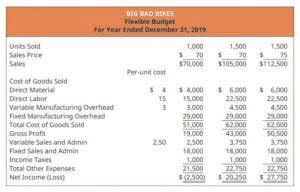Content

Accounts payable and accounts receivable play a big role in your company’s cash flow. In fact, small-to-medium businesses in the UK are routinely paid 18 days late for goods or services, while 1 in 6 of their invoices remain unpaid after a period of 90 days. Having so much cash languishing on your balance sheets can prove challenging, as it leaves businesses without enough capital to invest in growth or reduce debt. As a result, an effective accounts receivable business process flow can have a seriously beneficial effect on the financial health of your company. The Accounts Payable department is responsible for the financial, administrative and clerical support of a company. They are in charge of making payments owed by the company to suppliers and other creditors, paying vendor invoices or bills, and recording the company’s short-term debts. This department is vital for the smooth functioning of any business entity.

When payment is made to the creditor, cash is increased and accounts payable is decreased. When recording the transaction, cash is credited and accounts payable are debited.
What is an Example of Accounts Payable Expenses?
It is your list of short-term debts, ones that you need to pay off within the next month or so. Discover the ins and outs of accounts payable and how accounting automation can help your business. It ensures prompt payment of bills, which is important for the creditworthiness of a company and helps establish healthy relationships with vendors. For finance leaders, excellence in accounting practices, managing cash flow, producing better reporting and maximizing working capital are top of mind, and both AR and AP are fundamental to all of these. If your organization is growing rapidly, and your current AP staff is finding it difficult to keep up with the amount of invoices they are managing, you might decide that it is time to hire another person.
- If the company receiving the goods does not sign a promissory note, the vendor’s bill or invoice will be recorded by the company in its liability account Accounts Payable .
- When the items are for inventory, these will go under trade payables.
- This method is time and resource-intensive without an accounts payable automation platform.
- Also known as invoice processing, invoice management is the process by which organizations track and pay vendor invoices.
Accounts payable is commonly known as short-term debts and obligations. To be safe, a company can begin processing the payment at least a few days before the due date. This way, you do not risk any penalties or other consequences for late payment. Sometimes, businesses need to travel for official or business purposes. Ideally, the company will cover any necessary expenses, including airfare or fuel, food and accommodation. Then the next thing to help the restaurants out would be an amnesty of accounts payable and bills. Sanders later got a job with the company in 1997 and still works there in accounts payable at their Gilbert facility.
The Importance of Accounts Payables
We’ve tracked down a few frequently asked ones and are ready to deliver the best answers below. Assume, for example, that Acme Manufacturing needs to order a $10,000 piece of machinery. Before the order is placed, the plant manager must complete https://www.bookstime.com/ a PO, which lists the machinery’s price and other details. Transportation OptionsTheBull City Connectoris a fare-free, hybrid-electric bus service that connects downtown Durham with the Duke University campus and medical facilities.

This is accounts payable, and will normally have a credit period of 30 days or more. It’s best to be careful, as some transactions involve significant amounts of money. A well-implemented accounts payable process also ensures security on both ends.
Use accrual accounting
When a company pays their supplier, the company needs to debit accounts payable so that the credit balance can be decreased. Inefficiencies caused by inevitable human error can additionally result in late payments, missed opportunities (ex. discounts for early bill pay), and inaccurate payments. Some people mistakenly believe that accounts payable refer to the routine expenses of a company’s core operations, however, that is an incorrect interpretation of the term. Expenses are found on the firm’s income statement, while payables are booked as a liability on the balance sheet. Although many companies still handle accounts receivable via email, accounts receivable process automation can be a great way to encourage customers to pay more quickly.
What is a ledger in accounts?
An accounting ledger is an account or record used to store bookkeeping entries for balance-sheet and income-statement transactions. Accounting ledger journal entries can include accounts like cash, accounts receivable, investments, inventory, accounts payable, accrued expenses, and customer deposits.
When your accounting department needs to enter a handful of invoices into your accounting software, it seems like it would be easiest to enter all of them in a single batch. The corporation exemption does not apply to medical corporations for payments of medical or health care services or legal corporations for payment of legal services. Designed for freelancers and small business owners, Debitoor invoicing software makes it quick and easy to issue professional invoices and manage your business finances. QuickBooks accounting software to scan invoices, post payables into your accounting system, and pay invoices electronically. Acme posts a debit to decrease accounts payable (#5000) and a credit to reduce cash (#1000).
Is Accounts Payable a Debit or Credit Entry?
This can cause delays in processing an invoice and paying the vendor. Delays along the account payable cycle can snowball into late receipts of ordered items, poor credit rating, poor relationships with vendors and fees/fines. Most businesses have a separate AP department that handles all incoming bills/invoices and processes payments to vendors. This can involve lots of paperwork and man-hours spent reconciling details across invoices, POs & receipts. For example, if a company purchases goods for $780, it will record a $780 credit under accounts payable, and a $780 debit to the expense account.
- This could be due to inefficient invoice processing or challenges within the supply chain.
- To conserve cash, you may want to take more time before you pay invoices.
- Vendors and suppliers would not be too keen on doing business with someone who does not pay on time.
- Debtthat a company owes to its suppliers for products received before a payment is made.
- One is to require all new suppliers to fill out a Form W-9 before they are initially paid.
As companies advance into the digital era, more and more are switching to electronic invoicing services to automate their accounts payable departments. Some even believe it to be an industry standard in the near future. According to a report done by the GXS team in 2013, Europe is adopting government legislation encouraging businesses to adopt electronic invoicing practices. The United States has no such legislation yet but does recognize the value of this technology. The US Treasury estimated that implementing e-invoicing across the entire federal government would reduce cost by 50% and save $450 million annually. Accounts payable , or “payables,” refer to a company’s short-term obligations owed to its creditors or suppliers, which have not yet been paid. Payables appear on a company’s balance sheet as a current liability.
Accounts Payable vs Accounts Receivable
Once the match is verified by the AP department, the payment is initiated. It issues a purchase order to its supplier, Supplier Inc., for the ten items, at a price of, say, $15 per pen drive, to be delivered in five days. Set up touchless AP workflows and streamline the Accounts Payable process in seconds. At the end of the process, the amount that was “payable” at the first step, would no longer be a liability.
Is PPE a current asset?
PP&E and Noncurrent Assets
They are considered to be noncurrent assets because they provide value to a company but cannot be readily converted to cash within a year.
An accounts payable is recorded in the Account Payable sub-ledger at the time an invoice is vouched for payment. Vouchered, or vouched, means that an invoice is approved for payment and has been recorded in the General Ledger or AP subledger as an outstanding, or open, liability because it has not been paid. Payables are often categorized as Trade Payables, payables for the purchase of physical goods that are recorded in Inventory, and Expense Payables, payables for the purchase of goods or services that are expensed. Common examples of Expense Payables are advertising, travel, entertainment, office supplies and utilities. AP is a form of credit that suppliers offer to their customers by allowing them to pay for a product or service after it has already been received. Payment terms may include the offer of a cash discount for paying an invoice within a defined number of days.
82% of organizations were subject to successful fraud in 2019 due to poor internal controls and audits. Having sufficient operating procedures is extremely important to reduce improper payments, ensure regulatory compliance, and reduce the risk of human error. Working capital, or net working capital , is a measure of a company’s liquidity, operational efficiency, and short-term financial health. Reconciliation is an accounting process that compares two sets of records to check that figures are correct, and can be used for personal or business reconciliations. Track the invoice – Invoices will be tracked on a regular basis, and if payment hasn’t arrived, reminders will be sent to customers.
- This process can take from a few hours to several days, depending on the extent of the invoice.
- Accounts payable and trade payables often get used interchangeably, but the two terms have slightly different meanings.
- Harold Averkamp has worked as a university accounting instructor, accountant, and consultant for more than 25 years.
- The accounts payable department pays attention to how much you owe and when you should pay it.
- Making timely payments is a great way to maintain good relationships with your vendors and suppliers.
- Find out more about these key business functions and learn how they work in real terms.
This shows the average number of days it takes your company to make payments to creditors and suppliers and indicates how well you’re managing both cash flow and supplier relationships. With the cash-basis accounting method, a company records expenses when it actually pays suppliers. StyleVision would record the $500 down-payment on the frames when it places and pays for the order, and then post the $500 balance when it receives the frames and issues that final payment. Once the company pays the account, the items are removed from the balance sheet. Accounts payable can generally bedischargedwithoutinterestif paid within 30 days, but after 30 days the accounts will usually begin to accrue interest.
Receive the vendor invoices
One common example is the amount owed to you for goods sold or services your company provides to generate revenue. It also helps better management of cash flow by enabling payments only when due, using the credit facility offered by vendors. This article dives deep into the accounts payable process, AP workflows, and how this can all be automated with Nanonets intelligent automation platform. In addition, processes need to be in place to ensure that suppliers are paid on time, in order to avoid late payment fees and the risk of reputational damage which can arise due to tardy payments. Another component of the role is handling any exceptions that may arise, such as failed payments.
Invoice data extractionThe AP process is just one part of the entire procure to pay process that covers all stages of activity from purchase requisition to procurement & vendor payments. A solid system of monitoring and paying accounts payable gives you a clear picture of your expenditures against your revenue, enabling better business decisions. Get invoice approval from the appropriate person before entering it.The person approving the invoice should be different than the one entering it.
How to Record Accounts Receivable
An important part of accounts payable’s role is to ensure that robust internal controls are in place to avoid errors, such as duplicated payments or incorrect sums being paid. Accounts payable is all current liabilities owed to suppliers and other parties. As such, accounts payable is a liability account; it is not a business expense.

From a management perspective, it is of some importance to have accurate accounts payable records, so that suppliers are paid on time and liabilities are recorded in full and within the correct time periods. Otherwise, suppliers will be less inclined to grant credit, and the financial results of a business may be incorrect. This means that accounts payable must be processed exactly in accordance with a strict procedure that is followed in exactly the same way, every time. AP departments are responsible for processing expense reports and invoices and for ensuring payments are made. A skilled AP team keeps supplier relationships positive by making sure vendor information is accurate and up-to-date and bills are paid on time.
If you want to get a complete picture of your cash flow, use the… With electronic invoices to avoid any mistakes, print the invoice once and then file the email away to minimize confusion.

Recent Comments